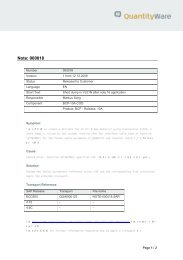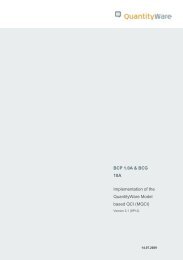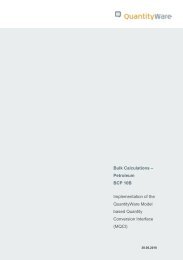QuantityWare - ASTM D1250-04_ASTM_D1250-80 comparison
QuantityWare - ASTM D1250-04_ASTM_D1250-80 comparison
QuantityWare - ASTM D1250-04_ASTM_D1250-80 comparison
- No tags were found...
You also want an ePaper? Increase the reach of your titles
YUMPU automatically turns print PDFs into web optimized ePapers that Google loves.
Based on our business impact decision matrix (see Annex C), thefinancial impact of a change from <strong>ASTM</strong> <strong>D1250</strong>-<strong>80</strong> to the <strong>ASTM</strong> <strong>D1250</strong>-<strong>04</strong>version is medium to low for <strong>ASTM</strong> <strong>D1250</strong>-<strong>80</strong> tables 5. Business usersshould be informed that differences can occur with the probabilities givenin the table above, to avoid business process disruptions.5.5. Result analysis - tables 23 A, B and D – 19<strong>80</strong> and 20<strong>04</strong> gridThe following table summarizes our findings for tables 23 A, B and D. The table contains the %numbers of calculations which showed a difference with respect to the total number ofsuccessful calculations performed in the respective grid. We also print the maximum differencesin relative density units (dimension one) that we detected. More details can be found in chapter5.1 and chapter 5.2. The results for the 20<strong>04</strong> grid show the expected <strong>80</strong> % deviations, since theinput relative density for tables 23 (as well as for tables 24) is rounded to 0,0005 in <strong>ASTM</strong><strong>D1250</strong>-<strong>80</strong>, whereas <strong>ASTM</strong> <strong>D1250</strong>-<strong>04</strong> defines no rounding and the grid increment of 0,0001defines the accuracy as:<strong>ASTM</strong> <strong>D1250</strong>-<strong>80</strong> Table 23 :% differences found - 20<strong>04</strong> grid, within 19<strong>80</strong> rangesQuantity compared: Base relative density @ 60 °FA - crude oil B - products D - lubricantsall temperaturesMaximum difference (complete/90%) [1] 0,0003 / 0,0003 0,0003 / 0,0003 0,0003 / 0,0003complete grid 79,5% 79,7% <strong>80</strong>,0%90 % grid <strong>80</strong>,0% 79,9% <strong>80</strong>,0%temperatures below baseMaximum difference (complete/90%) [1] 0,0003 / 0,0003 0,0003 / 0,0003 0,0003 / 0,0003complete grid <strong>80</strong>,3% <strong>80</strong>,2% <strong>80</strong>,0%90 % grid <strong>80</strong>,2% <strong>80</strong>,1% <strong>80</strong>,0%temperatures equal or above baseMaximum difference (complete/90%) [1] 0,0003 / 0,0003 0,0003 / 0,0003 0,0003 / 0,0003complete grid 79,3% 79,6% <strong>80</strong>,0%90 % grid 79,7% 79,8% <strong>80</strong>,0%The results for the 19<strong>80</strong> grid are given in the following table:Comparison of <strong>ASTM</strong> <strong>D1250</strong>-<strong>04</strong> and <strong>ASTM</strong> <strong>D1250</strong>-<strong>80</strong> 27/49










![Petroleum ASTM D1250-80 SP09 [276.9 KByte] - QuantityWare](https://img.yumpu.com/48083876/1/184x260/petroleum-astm-d1250-80-sp09-2769-kbyte-quantityware.jpg?quality=85)
![SAP QCI in a Nutshell + Notes [761.4 KByte] - QuantityWare](https://img.yumpu.com/46691308/1/178x260/sap-qci-in-a-nutshell-notes-7614-kbyte-quantityware.jpg?quality=85)




